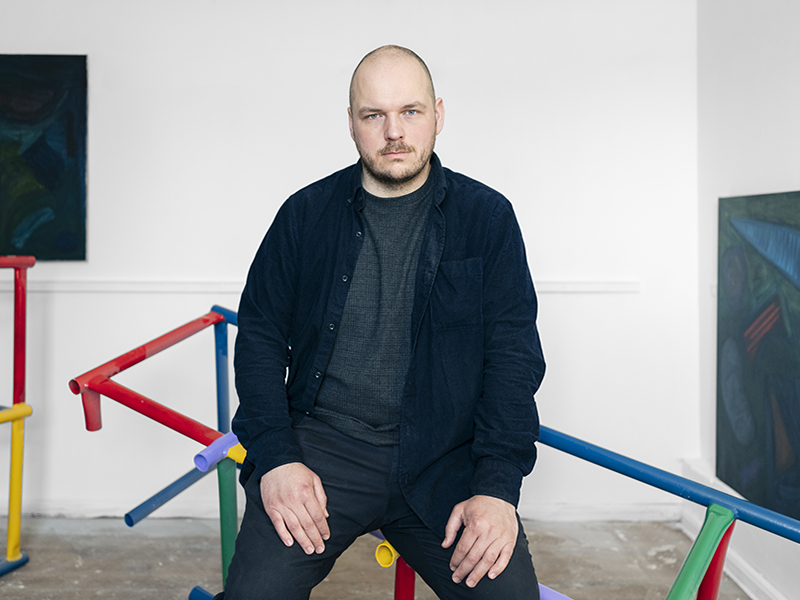The Playful, Poignant Sculptures of Polish Artist Przemek Pyszczek
The artist’s deceptively cheerful works were influenced by his homeland’s communist-era architecture and a lifelong sense of being an outsider
The artist’s deceptively cheerful works were influenced by his homeland’s communist-era architecture and a lifelong sense of being an outsider
Przemek Pyszczek’s colorful metal sculptures may look playful and fun—indeed the series of works is called Playground—but, as the Polish artist explains, they have a more serious back story. “I was inspired by the graphic elements that had been painted on communist-era mass-produced housing,” he says.
Born in Bialystok, Poland, Pyszczek and his family moved to Canada in the late 1980s. “My parents have always encouraged me to keep going, keep trying, and to be adventurous in following my dreams, something they did in building a new life from nothing.”
Here, he tells us more about his background, how a sense of otherness has informed his recent work, and how his upcoming projects are taking shape.

Do you come from a creative home?
I wouldn’t say I come from a creative home in a traditional sense. But my mom has always had a flair for fashion and home decor, and my dad used to work at a metal fabricator, and he was a good problem solver. He would make things we needed for the house like a TV stand, a Christmas tree holder, and more. He would often ask me to come up with furniture ideas for the house. The first thing I remember designing was a bed frame.
Beneath the bright surfaces and geometric forms of my work, I’m exploring tension and displacement
What was your childhood ambition?
Honestly, I wanted to be an artist. That’s the first thing I remember saying I wanted to be when I grew up. I remember my dad saying jokingly, “Well, we’d better get you an artist’s smock and beret then.”
You’ve said that a “feeling of displacement” informs your works?
Although Canada is a very multicultural country, my experience of growing up there wasn’t the same as that of most people I went to school with. My friends came from families who had been in Canada for generations, and they had a familiarity and feeling of place that I didn’t have.

It was also difficult to avoid feeling a feeling of displacement, as I had such an unusual name and my origin would come up every time I met a new person. At the same time, I didn’t feel fully Polish because I never really lived in Poland, so I felt like I was in a grey area between these two places and it’s something that has definitely informed my work as an artist.
What and where did you study, and why did you choose that subject?
I studied architecture at the University of Manitoba in Canada, completing my Bachelor of Environmental Design. In high school, I didn’t see being an artist as an attainable profession, and I was also interested in architecture. I was planning on becoming a teacher, but after taking an Introduction to Environmental Design class in first year at university, I changed my path. I was really fascinated by built environments and our experiences of them.
Can you describe your work to someone who’s never seen it?
On the surface, my work is bright and exuberant. At an art fair in New York a few years ago, the actor Jonah Hill came by and said the works reminded him of growing up in L.A. in the 1980s. I’ve also had people tell me that my work reminds them of the playgrounds they would play on as children. But beneath the bright surfaces and geometric forms of my work, I’m exploring tension and displacement within myself and the country in which I was born. I appropriate elements from the built world and reconfigure them.

What was the idea behind Playground?
I moved to Berlin from Canada in 2010, and started documenting the graphic elements painted on communist-era housing, and the security bars that people would have made for their windows and balconies for these buildings. I flattened these elements to produce my Façade series of paintings.
During the same period, I was at my grandma’s apartment and noticed the playground structures that were outside her building. They felt like Polish modernist sculptures to me, and as an artist I became fascinated by this other element of these housing estates. I started reconstructing and deconstructing the playground forms to create an abstract landscape, in conjunction with the Façade paintings.
Many of your works could be installed inside or out. Why?
Conceptually, the feelings that are invoked through the work can exist everywhere. But, to be quite honest, if someone feels joy from where they’ve installed a work of mine, they can place it anywhere.
What are you currently working on?
Right now, I have a solo exhibition at Galerie Derouillon in Paris. Once that’s done, I’ll be creating functional sculptures for a group exhibition at Berlinische Galerie, which I’m very excited about as it’s my first institutional show in Berlin. It runs until September.
przemekpyszczek.com
Banner image: Polish artist Przemek Pyszczek’s Playground series on display at Gallerie Derouillon in Paris. Paul Green